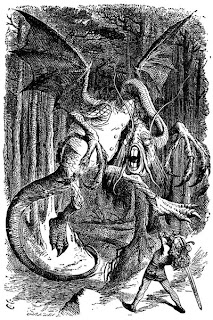Reading Notes: Through the Looking Glass, Part A
Lewis Carroll has such an interesting way of telling a story.
Not only are the characters that he creates unique and inventive, but they
stand out which such vivid detail that is it just tremendously easy to imagine
them. The way he uses words is also highly distinct – whimsy cuts through the
story because of the dialog between the normal Alice and the absolutely
abnormal circumstances. I’ve never read the sequel of Alice in Wonderland, so
this was interesting for me to read it. It was obvious right from the start
that this was a sequel to such a fabulous adventure from last time. He also has
a ways of putting pretty fantastic poetry within his stories, something that
people struggle with JUST having a poem in the middle.
An example of fine poetry (that’s funny at the same time)
was the “Jabberwocky” poem, which was filled with all sorts of great wordplay
and odd use of language. An example of odd wording was, “ ‘Twas brillig, and
the slithy toves”. I’m not even sure what this phrase was even supposed to mean
within the context of them poem and neither did Alice! For me, it gives the effect
of losing sanity within this world that Alice is caught in. Up is down. Left is
right. The words that people normally use are thrown out the window. Alice is
the empathetic character within this series.
The ideas that I’ve grabbed from this week’s stories were
having a sane protagonist maybe go into a world or place that makes no sense
when you apply normal rules of logic. It would definitely be a great challenge
to come up with situations and characters that make no sense when looking at them
from our point of view, but within their world, it makes perfect sense!

The Jabberwocky
Illustration by John Tenniel (1871)
"Through the Looking-Glass, and What Alice Found There" by Lewis Carroll (1871)

Comments
Post a Comment